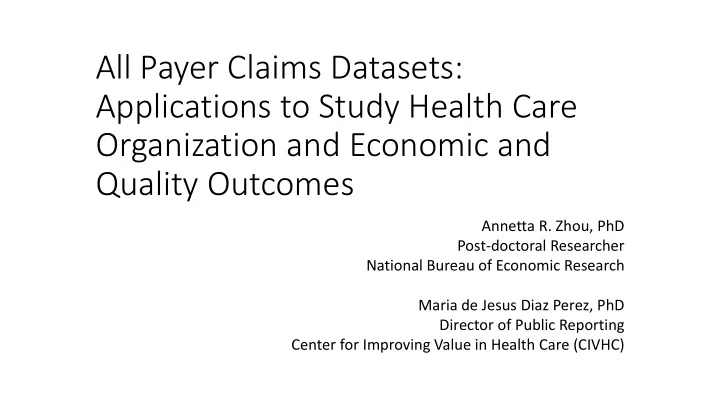

All Payer Claims Datasets: Applications to Study Health Care Organization and Economic and Quality Outcomes Annetta R. Zhou, PhD Post-doctoral Researcher National Bureau of Economic Research Maria de Jesus Diaz Perez, PhD Director of Public Reporting Center for Improving Value in Health Care (CIVHC)
The Comparative Health System Performance Initiative project Objectives • Classify and characterize types of health systems and compare their performance in terms of clinical and cost outcomes. • Identify characteristics of high-performing health systems. • Evaluate the role of PCOR in health system performance. • Disseminate findings broadly to help diffuse PCOR evidence across health systems nationally.
HDSA Partners 3 NRHI | Healthcare Delivery Systems Analysis
Ongoing CHSP Projects MHQP (Massachusetts): ▪ Assessing the relationships of Total Cost of Care, unit cost and use of services from 2013 to 2016 in system- and non-system affiliated practices. ▪ Examine the relationship between Practice Characteristics (from NSHOS Survey) and Patient Experience Survey results in Massachusetts. Comagine (Oregon and Utah): ▪ Comparing Total Cost of Care, and additional measures, between system- and non- system affiliated practices in the states of Utah and Oregon. CIVHC (Colorado): ▪ Pediatric Care Utilization, Spending and Quality for publicly and privately insured Children and young adults with different levels of medical complexity receiving care from system vs. non-system providers.
Sample Project: Specialization and Integration of Care for Medicaid Patients
Background and Motivation Research Questions: ▪ Do Medicaid and commercially insured patients go to different or similar providers? ▪ Do Medicaid patients receive better or worse quality of care from providers who treat a lot of Medicaid patients ? ▪ Maybe yes: there is return to specialization in treating Medicaid patients(e.g. care management) ▪ Maybe no: better reimbursement from commercial insurance may lead to greater investment in quality .
Methods Data ▪ CO APCD ▪ Enhanced Database (EDB) ▪ The EDB compiles managerial and financial ownership information from a number of data sets, including the Medicare Provider Enrollment, Chain, and Ownership System (PECOS), Medicare Claims Data on Provider Practice & Specialty (M-PPAS), Sk&A, Irving Levin, & S&P Capital IQ M & A Transactions. Patient attribution ▪ Attribute patient to PCP with the highest number of evaluation and management visits during a year ▪ Link PCPs to practices (TINs) and health systems using the EDB
Methods Quantifying integration: Medicaid focus of providers 𝑵𝒇𝒆𝒋𝒅𝒃𝒋𝒆𝑮𝒑𝒅𝒗𝒕 𝒋𝒌 = 𝜸 𝟐 𝑵𝒇𝒆𝒋𝒅𝒃𝒋𝒆 𝒋 + 𝜸 𝟑 𝒀 𝒋 + 𝝑 ▪ 𝑵𝒇𝒆𝒋𝒅𝒃𝒋𝒆𝑮𝒑𝒅𝒗𝒕 𝒋𝒌 is the share of all of patient i ’s PCP j ’s patients who are on Medicaid ▪ 𝑵𝒇𝒆𝒋𝒅𝒃𝒋𝒆 𝒋 indicates whether patient i is on Medicaid ▪ 𝒀 𝒋 are control variables that adjust for patient characteristics .
Results
Results
Results Care quality of Medicaid patients 100 90 80 70 60 50 40 30 20 10 0 A1c screening for diabetic Well child visit 3-6 years Chlamydia screening Adolescent wellness visits ACSC acute ACSC chronic patients Screening Measures (%) Ambulatory Care Sensitive Hospital Admissions (per 1000) high-Medicaid share providers low-Medicaid share providers high-Medicaid share providers low-Medicaid share providers
Results Care quality of Medicaid patients who switched providers 90 80 70 60 50 40 30 20 10 0 A1c screening for diabetic Well child visit 3-6 years Chlamydia screening Adolescent wellness visits ACSC acute ACSC chronic patients Screening Measures (%) Ambulatory Care Sensitive Hospital Admissions (per 1000) high-Medicaid share providers low-Medicaid share providers high-Medicaid share providers low-Medicaid share providers
Dissemination effort Local stakeholder engagement (dissemination and feedback) • MHQP, Comagine, and CIVHC - established advisory bodies (e.g., governance committee, advisory boards) to disseminate the research findings and gather feedback. • MHQP also used ad-hoc events and webinar to engage with specific stakeholder segments. • Comagine is holding one-on-one interviews with key stakeholders in both Utah and Oregon. • CIVHC will hold ad-hoc stakeholder feedback panels. NRHI: The Network for Regional Healthcare Improvement (nrhi.org) will provide communication and dissemination support to promote the learnings from these studies nationally.
Recommend
More recommend